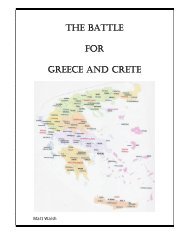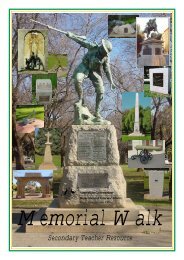Eastern Adelaide Teacher resource.pdf - Army Museum of South ...
Eastern Adelaide Teacher resource.pdf - Army Museum of South ...
Eastern Adelaide Teacher resource.pdf - Army Museum of South ...
Create successful ePaper yourself
Turn your PDF publications into a flip-book with our unique Google optimized e-Paper software.
First World War 5 ÷ 24 = 21%<br />
Second World War 5 ÷ 56 = 9%<br />
The figures suggest that many more Australians served during World War II. In fact<br />
just under one million Australians served in World War II compared to approximately<br />
330,000 in World War I.<br />
The comparative percentages also suggest that the likelihood <strong>of</strong> a service person<br />
surviving World War I was considerably less than during World War II.<br />
Some factors affecting casualty rates included;<br />
<br />
<br />
<br />
<br />
The tactics that were employed during the First World War, especially the period<br />
<strong>of</strong> trench warfare, which included frontal attacks by massed infantry against<br />
heavily defended positions.<br />
The ratio <strong>of</strong> personnel who served in the trenches or front lines, as opposed to<br />
support jobs in the First World War was much greater than in the Second World<br />
War.<br />
Many Australians, who served in the armed forces during World War II, were<br />
based in Australia in the event that the mainland was invaded. With some<br />
exceptions, such as parts <strong>of</strong> Northern Australia, the risk to life in these areas was<br />
minimal.<br />
Improvements in the treatment <strong>of</strong> the wounded also reduced the numbers who lost<br />
their lives during World War II. These included the application <strong>of</strong> surgical lessons<br />
learned from World War I and other advances in medicine, which reduced the<br />
numbers <strong>of</strong> those who, died from infection in the Second World War. Of<br />
particular importance in fighting bacterial infection was the development <strong>of</strong><br />
sulphur drugs in the 1930’s and the development <strong>of</strong> a powdered form <strong>of</strong> penicillin<br />
in 1941, which proved to be the most powerful antibacterial agent <strong>of</strong> World War<br />
II.<br />
History <strong>of</strong> penicillin: http://inventors.about.com/library/inventors/blpenicillin.htm<br />
(6) Record the names and initials <strong>of</strong> the servicemen on the World War II<br />
plaque with a cross next to their name.<br />
Dillon L.J.<br />
Hobbs H.C.<br />
Newman P.F.<br />
Smart E.R.<br />
Tregeagle J.R.<br />
(7) Record the name and initials <strong>of</strong> the last person to appear<br />
on the First World War plaque.<br />
Whitmore A.E.<br />
39











